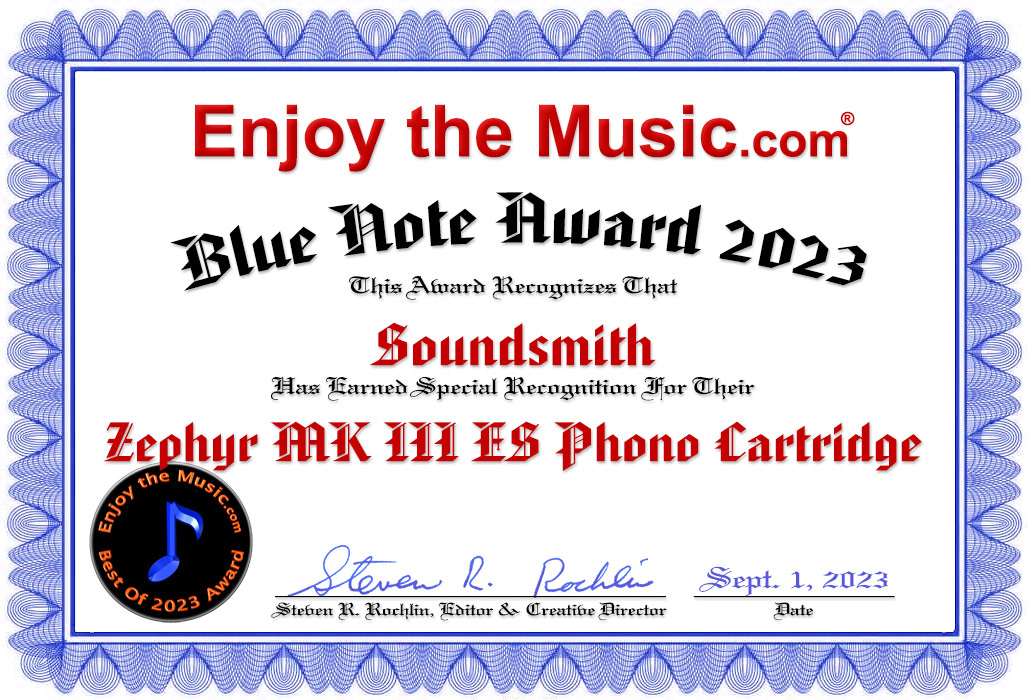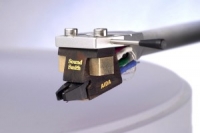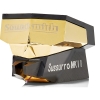Stylus Shape Information
So what is the big deal with stylus shapes?
Stylus Shape (part 1, part 2)
What I would like to do is to make as clear as possible why there are different stylus shapes, and what the advantages AND disadvantages are (both to manufacturers and owners). What follows below this very short dissertation is some of the standard information that is available on the internet, but I think it is important for me to preface it and voice my 50 plus years of experience and understanding in such a distilled way as to shed some light on what is to some a somewhat mysterious subject. First and foremost - all styli are a compromise of cost, performance and alignment difficulty.
The conical is by far the cheapest and easiest to manufacture. There are "bonded" styli and "nude" (solid diamond) styli. Bonded are cheapest, and is a process where a diamond is attached to a steel pin. It sounds complicated and unreliable, but it is a well known and highly developed low cost process. It is cheap, because one does not have to shape or form a whole diamond completely, or carefully, to allow bonding it to the cantilever. The process requires mounting the diamond to the steel pin and then grinding the diamond down to a conical shape. The steel pin is then pressed or swaged into the cantilever and glued in place. The drawback?? MASS - (The enemy of performance). Steel is HEAVY. Advantage?? LOW COST - certainly when compared to a nude stylus.
Elliptical styli come in various designs, from what is referred to a "faux" or "fake" elliptical (one not ground so well from a conical design) to Hyper-Ellipticals, which are precision ground and are actually often closer to Contact Line than most ellipticals. There are of course bonded elliptical and "nude" ellipticals, the latter being lower in mass.
Then, there are the "fine line" styli, including standard Contact Line, as well as the more esoteric evolutions such as Shibata, Micro Line or Micro Ridge, Optimized Contour Contact Line (Soundsmith) and so on. These are almost always nudes, for lowest possible mass. These designs have a sharper edge (radius) that play the record groove walls, which allows better high frequency reproduction (especially at the inner grooves where it is more difficult) resulting in lower distortion, better imaging, depth, and many other aspects of fine analog listening that are lost when the high frequencies are not resolved well - usually casued by lower quality stylus shapes.
The higher end designs, however, require far more precise alignment than the lower quality shapes, for what should be obvious reasons. It is easier to align a rounded end to a groove than a V shaped end. Alignment issues for both rotating off a vertical imaginary line in the groove looking end on (Azimuth alignment), as well as tilting front to back along the groove (side view - SRA or stylus rake angle) become far more critical for proper tracing of the groove.
Then there are noise and wear issues. Conicals statistically trace less surface area of the groove wall, so can theoretically pick up less record damage (unless they trace an area where there HAS been lots of wear or damage) and can pick up fewer sonic bursts from defects or noise from dirt or other foreign objects in the groove as they are playing less contact area. But the wear factor is higher (faster) for both the record and styli from conicals due to higher "force per unit area". Alignment considerations however, are much easier to achieve, with the sacrifice of far poorer high frequency response. For analog, that's bad.
Conversely, the fine line designs require records that are in better condition and cleaner to be played mainly noise free. But the reward for playing a good clean undamaged record with a properly aligned fine line diamond and quality cartridge cannot be overly described in terms of enjoyment.
The last basic considerations are the differences between Contact Line and the more esoteric Contact Line designs, such as the Micro-Ridge, Soundsmith OCL (Optimized Contour Contact Line) and others. The clearest message that I can relate is that all superior high end designs are compromises - all trying to do the best job, but the simple truth is that there is no such thing as a perfectly shaped stylus for all considerations. While the "basic" Contact Line is used by by far the majority of high end performance cartridge designs, there is always the desire to go farther. As you do, the azimuth and SRA alignments can become more difficult - difficult, but not impossible. Then the Anti-Skating becomes even more important, and our position is that almost every test record for setting anti-skating is designed incorrectly. Our method originates from the great audio engineer and tone arm designer/builder, Frank Schroeder, and we firmly believe it is technically correct to "first order" - far better than other methods. .
Our OCL stylus more closely resembles the cutting stylus used to make records than ANY other design. It requires exacting alignment. The true "Micro-Ridge" has one advantage over all other designs in that the radius of the groove wall tracing edges do NOT grow wider as it wears - BUT when it wear out, it does so suddenly and will damage records even with one play. All other designs degrade slowly as they are used.
Improper stylus azimuth alignment as performed by installer or owner for the more complex CL shapes can mean that the stylus does not fit the groove properly. That can cause performance detriment right away. As one of the major issues of cartridge performance is concerned, a first order concern to performance is reflected energy that goes back DOWN the cantilever as a result of improperly damped and reflected "stored," and resonant, energies in the moving system of cartridges. This (inertial) stored energy in the moving mass of the generator (a subject I speak about in detail on this website fixed-coil-vs-moving-coil-why-make-jump-different-technology causes the stylus to jitter about in the groove instead of staying in intimate contact - statistically speaking. This results in poor "sample rate" of the information on the record. Improper alignment of these superior stylus shapes will become very obvious if cartridge setup and alignments have been done poorly.
While these more esoteric stylus CL shapes are very desirable from a performance standpoint, they do require more precise azimuth alignment, and patience to get right. Once done correctly, the results are very much worthwhile, and can often be quite stunning, assuming the cartridge design supporting this type of stylus is worthwhile of these esoteric stylus shapes.
USB Microscopes. These devices have become quite popular and inexpensive and are often used to aid in aligning styli. They are not, however, to be considered the last say in how to align a stylus, especially when it comes to SRA, or stylus rake angle. A still image taken from what one hopes is a correct sideways view may or may not image the actual tracing edge of the stylus correctly. That edge does NOT have to line up with the body of the diamond, as is often assumed. The tracing edge can vary in position, depending on design and fixturing of the diamond which can vary plus or minus as much as 5 degrees, or be up to 20 degrees off axis of the body of the diamond in some designs, and will not be apparent during casual USB inspection.
More importantly the static position of a stylus on a smooth surface or record - not in motion - does in no way represent the final SRA of the playing system. The reason for that is simple and usually overlooked by experts and lay persons alike who suggest how to use a USB scope for SRA. When the record is in motion the frictional forces on the diamond causes the cantilever to swing upwards. How much?? That varies as a function of the vertical compliance, which can vary widely from model to model and even within one model type based on age and other factors.
So how DOES one set the SRA properly?? And how would one use a USB microscope?
The best method is to set THE TRACING FACET (IF you can see it!) at 94-95 degrees static (record not moving) and realize that when the record is moving it will swing the cantilever up and might swing the SRA up to 92 degrees. Adjust it by ear? How much? That is where your ears come in very handy. The voice of the singer should not be receded, and the bass should be tight. You should not have too much sibilance (if the SRA is too high) or the system sounding dull (tool ow an SRA), and Certain records will aid in this process and the internet is full of suggested ones.
I suggest starting with the tone arm parallel with the record surface as viewed from the right side (trusting the cartridge manufacturer to have gotten it right), and move the rear of the arm up or down from there to taste and performance.
Peter Ledermann / President / Soundsmith Corporation
Click this to read a blog about our Soundsmith OCL stylus and setting SRA
The below statements are some of those found openly on the internet, and are intended only as supplemental information, and not specifically endorsed by Peter Ledermann of Soundsmith - especially those statements pertaining to stylus life. We believe that styli should be checked carefully by microscopic exam by someone who knows what to look for at 1000 hours, as that is the typical maximum life for a properly aligned stylus before record damage begins.
The Conical Stylus

When long playing (LP) records were first invented, the only type of stylus was the conical / spherical type.
But there were issues...
The diameter of the stylus was too large for it to fit between the corrugations in the groove which recorded higher frequencies.
Reducing the diameter of the stylus was not possible as it would cause the contact patch to drop too far down the groove... and the tip of the needle might then drag along the bottom....
Solution: The invention of the elliptical stylus, simply put it has a small diameter at the sides and a large diameter front to back.
The Elliptical Stylus
The smaller the diameter of the side radius, the better the stylus can track/follow the high frequencies - suddenly sibilants no longer distort!

Standard elliptical sizes are:
- 0.4 x 0.7 mil / 10 x 18 um - budget styli
- 0.3 x 0.7 mil / 8 x 18 um - quality styli
- 0.2 x 0.7 mil / 5 x 18 um - premium styli

Line Contact & Shibata Styli
All simple so far right?
Well.... not quite.
When they developed CD4 Quad 4 channel recordings, they needed to be able to record and play back frequencies up to 45kHz - more than twice the highest goal frequency attained with the elliptical styli.
Also the very fine corrugations in the groove required for 45kHz could be more easily worn away, so a design was required that could 1) track much higher frequencies and 2) Reduce wear on the record.
The first stylus that achieved this was the now famous "Shibata" (named after its inventor).
(Edit: The earlier Pyramid stylus - released in the late 1950's appears to be the first attempt at a Line contact stylus, however at that time there was no pressing need for it in the market, and the concept appears to have failed commercially, and disappeared with very little trace. - The idea was then resurrected with the release of CD4 and the Shibata.)

Elliptical and Shibata Stylus showing contact patch
Proportions of the Shibata design
- 6 x 75 um - Shibata "large" design
- 6 x 50 um - Shibata "small" design
Rather than providing a small circular "dot" contact point with the groove, the more complex shape of the Shibata allowed a long vertical line of contact to be achieved with the groove wall.
The result of contacting more of the groove wall was the achievement of the two primary goals.
Through better wall contact tracking was improved and information retrieval improved (facilitating higher frequencies), and because the total contact surface area increased, the amount of pressure per square area was substantially reduced - less pressure equals less wear on both the record and the stylus.

In actual fact the side radius of the Shibata is about the same as a 0.2 mil elliptical - so theoretically they have the same ability to trace high frequencies, but the elliptical only ever contacts the same small area - which can become worn - resulting in degradation in high frequencies.
Playing back a record with a Shibata stylus which has been worn with a conical or elliptical stylus can result in near pristine sound - this is because the Shibata shape can "read" the groove wall in areas that were not contacted by the simpler stylus shapes.
After the release of the Shibata, various competitors developed very similar shapes which were (and are) marketed under various names:
- Hyper Elliptical (various sizes!)
- Stereohedron 0.3 x 2.8 mil / 7 x 72 um
- Line Contact (various sizes)
- Fine Line 8 x 40 um
These are all much the same.
Exotic Styli
The next development was driven by a designer called Van Den Hull in Holland - using computer analysis he developed a stylus shape which replicated the head of the cutter used to make the original vinyl masters as closely as possible, while reducing the side radius further.
This meant two things: 1) the reduction in side radius reduced distortion and improved tracking of the high frequencies, and 2) the increase in the length of the contact patch further reduced wear and increased longevity of stylus and record.
This led to the next wave of stylus shapes, again known by various names:
- Micro Line 2.5 x 75 um
- Micro Ridge 3.8 x 75 um
- VanDenHull 4 x 70 um
- FritzGeiger 5 x 70 um
- SAS 2.5 x 75 um
- Paratrace 4 x 70 um
Although the proportions of the individual designs vary a little - the side radius in most of these is around two thirds to half that of a Shibata - so effectively 0.1mil.

These "Exotic" styli are usually made by computer guided laser cutting of diamonds to a precise pattern - and the price also reflects the additional effort required to manufacture these.
Wear, Tear and Life
So we know that the more extreme line contacts reduce wear.... but what is the difference?
Apparently according to Jico (manufacturer of the highly regarded SAS stylus), the amount of playing time where a stylus will maintain its specified level of distortion at 15kHz is as follows:
- Spherical / Conical - 150hrs
- Elliptical - 250hrs
- Shibata/Line contact - 400hrs
- SAS/MicroRidge - 500hrs
This is not to say that at 500 hrs a SAS stylus is "worn out" - but at that stage the wear has reached the point where distortion at 15kHz surpasses the level specified by Jico for a new stylus. (Which I believe is 3%).
Some manufacturers have traditionally defined a stylus as being "worn out" when it starts to damage the record... in these terms the figures provided by Jico can at least be doubled, and in some cases quadrupled.
Summary
In pure sonic terms on pristine vinyl a top notch elliptical can do as well as all but the very best Line Contact / Shibata styli, but will ultimately be surpassed by the better MicroLine styli.
However in terms of reduced wear on both stylus and records - the entry point is the Line contact / Shibata category.
In terms of playing back worn vinyl line contact stylus types also have an advantage in that they can contact "virgin" unworn vinyl.
Narrower side radius = improved tracking and reduced high frequency distortion.











